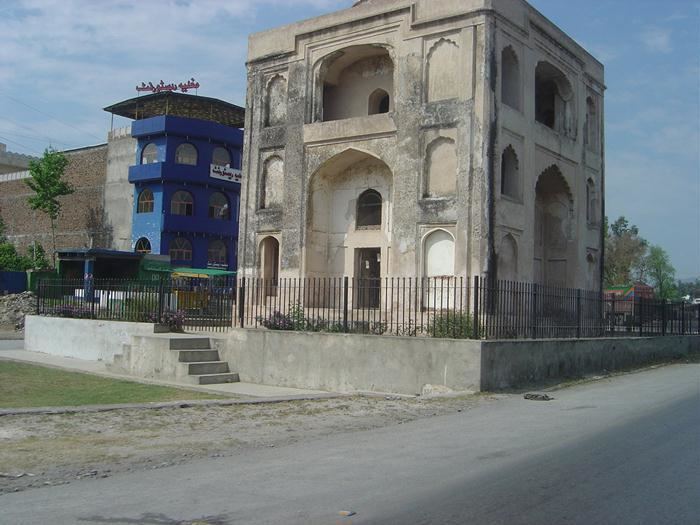 | ||
Attock Khurd (Little Attock) is a small town located on the River Indus in the Attock District of Punjab, Pakistan. Historically and strategically, Attock Khurd is considered the gateway to Central Asia since it is near Khyber-Pakhtunkhwa border.
Contents
- Map of Attock Khurd Pakistan
- Ancient history
- Mughal Maratha Afghan and Sikh rule
- British Era
- Sufis and saints
- Railway
- Sites of interest
- References
Map of Attock Khurd, Pakistan
Ancient history
Attock Khurd (the old city) has a rich history and was of special importance to the entire sub-continent. The great grammarian Pāṇini (पाणिन), who wrote the Aṣṭādhyāyī, the oldest surviving Sanskrit grammar, is said in some historical sources to have been born near Attock in Shalātura, modern Lahur, on the right bank of Indus River in the ancient Kambojan/Gandharan territory in 520 BCE. In those days Attock was located on the high road, the Uttarapatha, the principal route of international commerce and communication between the sub-continent, Persia and China.
Attock then finds its name in the history books dating to the rule of Chandragupta's grandson Ashoka, the Emperor of upper India, who had converted to the Buddhist faith. In the Edicts of Ashoka, set in stone, some of them written in Greek, it is declared that Greek populations within his realm also had converted to Buddhism:
"Here in the king's domain among the Greeks, the Kambojas, the Nabhakas, the Nabhapamkits, the Bhojas, the Pitinikas, the Andhras and the Palidas, everywhere people are following Beloved-of-the-Gods' instructions in Dharma."In the spring of 326 BCE Alexander III of Macedon passed into the Punjab (at Ohind, 16 m. above Attock), using a bridge over the Indus constructed by Perdiccas and Hephaestion. The region became part of the Kingdom of Ederatides the Greek or Indo-Greek Kingdom, who extended his power over western Punjab. The Indo-Greek kings held the country after him (until about 80 BCE) until its invasion by the Indo-scythians.
When the Chinese pilgrim Hiuen Tsang visited the district in 630 CE and again in 643 CE, Buddhism was rapidly declining. The Brahman revival, to which India owes its present form of Hinduism, had already set in the early years of the fifth century, and must have been at its height in the days of Hiuen Tsang. From that time the light afforded by the records of the Chinese pilgrims fades.
The country was under the dominion of the Hindu kings of Kashmir, and remained so till the end of the 9th century. After that, the district became part of the Kingdom of the rulers of Kabul -- and the town, then known as Udhabandhapur or Waihind, their capital until 1001 when the capital was moved to Nandana in Salt Range after Battle of Peshawar (1001) -- Samanta Deva and his successors (more accurately designated as the "Hindu Shahis of Kabul"), who remained in possession till the times of Mahmud Ghaznavi. With the passage of time, the Gakhars became strong in the hills to the east, but their dominion never extended beyond the Margalla pass and the Khari Moorat.
But the story always less told by historian that place got more fame by their Sadat,s (Sufi,s & saints) which were mostly consist of Bukhari-ul-Naqvi & Bhakkaries. local resources told us 109 Sufi,s saints have belong these families, like most fame Reeas-ul-Abdal Hazrit Dewan Syed Imam Jafer Shah Bukhari-ul-Naqvi almaroof Syed Chakar Shah Bukhari (titled Dewan,s of Attock), which was grand grand son of Hazrit Makhdoom Jahaniyan Jahangasht (Uch Sharif) & which was grand son of Hazrit Jalaluddin Surkh-Posh Bukhari (Urdu: سید جلال الدین سرخ پوش بخاری c. 595-690 AH, 1199–1291 CE). which was titled by Dewan,s of Attock in last era of Lodhi, period.
Mughal, Maratha, Afghan and Sikh rule
Akbar the Great built Attock Fort from 1581 - 1583 under the supervision of Khawaja Shamsuddin Khawafi to protect the passage of the Indus. Attock was won by Marathas led by Peshwas (Prime Ministers of Maratha rulers, based in Pune) between 1751-1760. The brother of then Peshwa Balaji Bajirao named Raghunathrao won Attock. (See: Battle of Attock, 1758 & Battle of Peshawar)
It saw countless battles and skirmishes between the Sikhs and the Afghans in later years.
In 1813, the Sikh Empire wrested the Attock Fort from the Kingdom of Kabul in the Battle of Attock. Maharaja Ranjit Singh's commander Mohkam Chand wrested this strategically placed fort on the left bank of the Indus river from Shah Mahmud's vazier, Fateh Khan Barakzai. This fort had secured the passage of the Afghans to-and-from Kashmir. In 1833, Hari Singh Nalwa, the Commander-in-Chief of the Sikh Empire's army along its border with the Kingdom of Kabul, strengthened Akbar's fort of Attock by building the very high and massy bastions at each of its gates.
British Era
As a result of the First Anglo-Sikh War (1845–1846), the Fort was surrendered to the British. It was briefly lost to the Sikhs during the Second Anglo-Sikh War (1848–1849) but recaptured towards the end.
Sufi,s and saints
Railway
The Attock Khurd railway station is situated near Old Attock Bridge on main railway line. This railway station was built around 1885 during British rule. In March 2007 it has been renovated and declared a tourist resort.
It is one of the most beautiful railway station of Pakistan. It is surrounded by lush green hills, and its magnificent building has Victorian architecture and composed of stone masonry.
It is the gateway to Attock Bridge. All trains run between Rawalpindi & Peshawar pass through this station without stopping here.
